
ISSN: 2615-9740
JOURNAL OF TECHNICAL EDUCATION SCIENCE
Ho Chi Minh City University of Technology and Education
Website: https://jte.edu.vn
Email: jte@hcmute.edu.vn
JTE, Volume 19, Special Issue 03, 2024
72
Introduction to Algebraic Deformation Theory and The Case of k-Linear
Categories
Van Hoang Dinh
Ho Chi Minh City University of Technology and Education, Vietnam
*Corresponding author. Email: hoangdv@hcmute.edu.vn
ARTICLE INFO
ABSTRACT
Received:
29/04/2024
Deformation theory is a branch of mathematics which studies how
mathematical objects, such as algebraic varieties, schemes, algebras, or
categories, can be deformed “continuously” depending on a space of
parameter while preserving certain algebraic or geometric structures.
Algebraic deformation theory, which was pioneered by Murray
Gerstenhaber in 1960s-1970s, established its role as a cornerstone in
modern mathematics and theoretical physics. This theory provides a
powerful framework for understanding the subtle variations and
deformations of mathematical and physical objects depending on a
parameter space. Lying at the interface of algebra, geometry and topology
this theory has been being studied extensively worldwide and obtained
many applications in various areas of mathematics and theoretical physics,
such as the study of Calabi-Yau manifolds, mirror symmetry, quantum
physics. In such context, this article aims to introduce this important
mathematical theory to the community of Vietnamese mathematicians in a
hope to bring more attention of Vietnamese mathematicians and math
students to this vibrant research area. We also expect that this topic will be
taught at universities in Vietnam in the near future.
Revised:
16/05/2024
Accepted:
22/05/2024
Published:
28/08/2024
KEYWORDS
Algebra;
Deformation theory;
Hochschild cohomology;
Lie algebra;
Category theory.
Doi: https://doi.org/10.54644/jte.2024.1575
Copyright © JTE. This is an open access article distributed under the terms and conditions of the Creative Commons Attribution-NonCommercial 4.0
International License which permits unrestricted use, distribution, and reproduction in any medium for non-commercial purpose, provided the original work is
properly cited.
1. Introduction
In mathematics, deformation theory studies how a mathematical objects (like varieties, manifolds,
algebras, etc.) in certain space can be varied dependently on points of a parameter space. Foundations
of deformations theory was initiated in the works of A. Grothendieck, K. Kodaira, D.C. Spencer in the
1950’s. In later years, in the ground breaking paper [5], M. Gerstenhaber introduced algebraic
deformation theory for algebras and rings. In the following years, Gerstenhaber’s deformation theory
was studied intensively by a large number of mathematicians in various areas of mathematics. This
theory has obtained far-reaching applications across diverse areas of mathematics and theoretical
physics. Nowadays, algebraic deformation theory stands as a cornerstone at the interface of several
fundamental research areas in mathematics including algebra, geometry, topology and mathematical
physics.
Beyond the study about how algebraic structures such as associative algebras, Lie algebras, and
morphisms between them behave under continuous perturbations, in recent years, various flavours of
deformation theory have been studied intensively including:
(1) Deformations of Poisson structures were studied by D. Kaledin, M. Kontsevich, D. Tamarkin,
S. Merkulov. Most remarkable is the work on deformation quantization of Poisson structure [10], which
brought Kontsevich to the Fields medal award in 1998.
(2) Deformations of abelian categories, presheaves, prestacks, were studied by M. Van den Bergh,
W. Lowen, H. Dinh Van, L. Hermans, etc. in [12], [14], [13], [1], [2], [3]
(3) Deformations of monoidal categories were studied by D. N. Yetter, T. Shrestha [19].
(4) Deformations of operads were studied by M. Markl, S. Merkulov, B. Vallette, ect. in [18], [15],
[17].

ISSN: 2615-9740
JOURNAL OF TECHNICAL EDUCATION SCIENCE
Ho Chi Minh City University of Technology and Education
Website: https://jte.edu.vn
Email: jte@hcmute.edu.vn
JTE, Volume 19, Special Issue 03, 2024
73
In the context that the theory of deformations is being studied extensively world-wide, to the best of
my knowledge, there are very few Vietnamese mathematicians doing research in this field. Therefore,
the main purpose of this article is to introduce the basic knowledge of deformation theory to
mathematicians in Vietnam and hopefully to attract more Vietnamese mathematicians to participate in
this vibrant research area.
This paper is organized in three Sections. The main part is Section 2, in this section we present the
basic knowledge of deformation theory, we introduce the Hochschild cohomology and clarify its
indispensable role in classifying deformations. There are many references on this topic such as [7],
[6],[4], [11], [16]. Among these references, perhaps the long paper by Gerstenhaber-Schack [7] is the
best overview on the subject. However, we writing this note at a more elementary level in the hope that
it will make the general theory more accessible to the non-expert. After basic theory of algebraic
deformation, in Section 3, we show that how this theory is applied to the case of k-linear categories. In
particular, we show that first order deformations of a k-linear category is controlled by its second
Hochschild cohomology group.
2. Deformation for associative algebras
In this section, we present basic notions and properties of algebraic deformation pioneered by
Gerstenhaber in 1960s. There are numerous references in scope and depth about this topic in the
literature, such as [7], [6], [4], [11], [16]. Of those, the paper [7] may be the best overview on the subject.
Thorough this paper, k is a field and A is an algebra over k.
2.1. Hochschild cohomology
Hochschild (co)homology is introduced in the seminal paper [8] by G. Hochschild. Later it become
a fundamental tool in study deformation theory. For those results presented in this subsection which we
do not prove, the reader can find their proofs in [8], [16].
Definition 2.1. Let M be an A-bimodule. The group of n-Hochschild cochains is
𝐶𝑛(𝐴,𝑀)=ℎ𝑜𝑚𝑘(𝐴𝑛,𝑀)
(1)
and the differential 𝑑𝑛 : 𝐶𝑛(𝐴,𝑀)→ 𝐶𝑛+1(𝐴,𝑀) is defined as:
𝑑𝑛(𝑓)(𝑎0,𝑎1,…,𝑎𝑛)=𝑎0𝑓(𝑎1,…,𝑎𝑛)+∑(−1)𝑖+1𝑓(𝑎1,…,𝑎𝑖𝑎𝑖+1,…,𝑎𝑛)
𝑛−1
𝑖=0
+(−1)𝑛+1𝑓(𝑎0,…,𝑎𝑛−1)𝑎𝑛
(2)
where 𝑓 ∈ 𝐶𝑛(𝐴,𝑀) and 𝑎0,𝑎1,…,𝑎𝑛 in A. It is straight forward to check that 𝑑𝑛+1 o 𝑑𝑛=0 for any
𝑛≥1. The n-Hochschild cohomology group is
HHn(A, M) = Hn (C• (A, M)) = Ker(dn)/Im(dn-1)
(3)
Example 2.2. For a cochain f ∈ C2 (A) := C2 (A, A), we have that d2 (f) (a, b, c) = af (b, c) – f (ab, c) + f
(a, bc) – f (a, b)c.
Lemma 2.3. HH0 (A, M) ≃ {m ∈ M : am = ma, ∀a ∈ A}. In special case M = A, it follows that HH0 (A)
is the center of A.
Proof. We have C0 (A, M) = homk (k, M) = M and C1 (A, M) = homk (A, M) Take a cochain m ∈ M. m
∈ ker(d0) if d0 (m)(a) = am - ma = 0 or am = ma. □
Lemma 2.4. HH1 (A, M) ≃ Der(A, M) /InnDer(A, M)
Proof. Consider a cochain f ∈ C1 (A, M). Assume that f ∈ Kerd1, then d1(f)(a, b) = af(b) - f(ab) + f(a)b
= 0, ∀a, b ∈ A. It follows that f(ab) = af(b) + f(a)b, or f ∈ Der(A, M). The image of d0 is given by function
g ∈ homk (A, M) where g(a) = am - ma. It is easily to verify that g(ab) = g(a)b + ag(b). These such
function forms the set of inner derivative InnDer(A, M). So Im(d0) = InnDer(A, M). □
Definition 2.5. (Gerstenhaber bracket). Let f
∈
Cm(A, A) and g
∈
Cn(A, A). We
define Gerstenhaber bracket [f, g]
∈
Cm+n-1 as follows.
[𝑓,𝑔]=𝑓 o 𝑔−(−1)(𝑚−1)(𝑛−1)𝑔 o 𝑓
(4)
where

ISSN: 2615-9740
JOURNAL OF TECHNICAL EDUCATION SCIENCE
Ho Chi Minh City University of Technology and Education
Website: https://jte.edu.vn
Email: jte@hcmute.edu.vn
JTE, Volume 19, Special Issue 03, 2024
74
(𝑓 o 𝑔)(𝑎1,…,𝑎𝑚+𝑛−1)
= ∑ (−1)(𝑚−1)(𝑖−1)𝑓(𝑎1,…,𝑎𝑖−1,𝑔(𝑎𝑖,…,𝑎𝑖+𝑛−1),𝑎𝑖+𝑛,…,𝑎𝑚+𝑛−1)
𝑚+𝑛−1
𝑖=1
(5)
for any 𝑎1,…,𝑎𝑚+𝑛−1 ∈𝐴.
Proposition 2.6. Let 𝑓∈𝐂𝑚(𝐴,𝐴),𝑔∈𝐂𝑛(𝐴,𝐴) 𝑎𝑛𝑑 ℎ∈𝐂𝑝(𝐴,𝐴). Then
(1) [𝑓,𝑔]=−(−1)(𝑚−1)(𝑛−1)[𝑔,𝑓].
(2) (−1)(𝑚−1)(𝑝−1)[𝑓,[𝑔,ℎ]]+(−1)(𝑛−1)(𝑚−1)[𝑔,[ℎ,𝑓]]+(−1)(𝑝−1)(𝑛−1)[ℎ,[𝑓,𝑔]]=0.
(3) 𝑑𝑚+𝑛−1([𝑓,𝑔])=[𝑑𝑚(𝑓),𝑔]+(−1)𝑚−1[𝑓,𝑑𝑛(𝑔)]
Corollary 2.7. Let 𝐂(𝐴)=𝑛=0
∞𝐂𝑛(𝐴,𝐴), and let 𝛿(𝑓)=(−1)𝑚−1𝑑𝑚(𝑓) for 𝑓∈𝐶𝑚(𝐴). Then
(𝐂(𝐴),[−,−],𝛿) is a graded Lie algebra.
2.2. Deformation theory
Deformation theory for algebras was developed by Gerstenhaber in 1960’s, this theory is closely
parallel to deformation theory for complex analytic structures initiated by Kodaira and Spencer [9].
Let A be an algebra over the field k. Denote by A[[t]] the algebra of formal power series ∑𝑎𝑖𝑡𝑖
∞
𝑖=0
with coefficients 𝑎𝑖∈𝐴. The addition and multiplication are defined as follows:
(∑𝑎𝑖𝑡𝑖)+(∑𝑏𝑗𝑡𝑗)=∑(𝑎𝑖+𝑏𝑖)𝑡𝑛
∞
𝑖=0
∞
𝑗=0
∞
𝑖=0
(6)
(∑𝑎𝑖𝑡𝑖)(∑𝑏𝑗𝑡𝑗)=∑( ∑ 𝑎𝑖𝑏𝑗)𝑡𝑛
𝑖+𝑗=𝑛𝑛≥0
∞
𝑗=0
∞
𝑖=0
(7)
A new multiplication µt on A[[t]] can be defined as:
𝜇𝑡(𝑎,𝑏)=∑𝜇𝑖(𝑎,𝑏)𝑡𝑖=𝑎𝑏+𝜇1(𝑎,𝑏)𝑡+𝜇2(𝑎,𝑏)+⋯
∞
𝑖=0
(8)
where µi
∈
C2(A, A), µ0 is exactly the multiplication of A, and a, b
∈
A. This multiplication is defined
for elements in A but it is extended linearly to all elements in A[[t]].
Definition 2.8. We define deformations of A as follows:
• A formal deformation of A is the pair (A[[t]], µt) in which the multiplication µt is associative that
make A[[t]] into an algebra over k[[t]].
• The deformation (A[[t]], µt) in which µi = 0 for i ≥ 1 (µt = µ0) is called trivial deformation of A.
• If we set t2 = 0 then (A[[t]] = A
⊕
At, µt = µ0 + µ1t) is called first order deformation of A.
Example 2.9. Let 𝐴=𝑘[𝑡]. Set 𝜇𝑖(𝑥𝑚,𝑥𝑛)=𝑚𝑖𝑛𝑖
𝑖! 𝑥𝑚+𝑛, we define 𝜇𝑡=∑𝜇𝑖𝑡𝑖
∞
𝑖=0 . By direct
computations, one can show that µt is an associative multiplication of
A[[t]], thus (A[[t]], µt) is a deformation of the algebra A.
Let look at the associativity of µt:
µt(µt(a, b), c) = µt(a, µt(b, c)),
∀
a, b, c
∈
A
(9)
Expand the left hand side we have that
𝜇𝑡(𝜇𝑡(𝑎,𝑏),𝑐)=𝜇𝑡(∑𝜇𝑖(𝑎,𝑏)𝑡𝑖,𝑐)=∑∑𝜇𝑗(𝜇𝑖(𝑎,𝑏),𝑐)𝑡𝑖+𝑗
∞
𝑖=0
∞
𝑗=0
∞
𝑖=0
=∑( ∑ 𝜇𝑗(𝜇𝑖(𝑎,𝑏),𝑐)𝑡𝑛
∞
𝑖+𝑗=𝑛
∞
𝑛=0
(10)

ISSN: 2615-9740
JOURNAL OF TECHNICAL EDUCATION SCIENCE
Ho Chi Minh City University of Technology and Education
Website: https://jte.edu.vn
Email: jte@hcmute.edu.vn
JTE, Volume 19, Special Issue 03, 2024
75
Similarly expansion for the right hand side
𝜇𝑡(𝑎,𝜇𝑡(𝑏,𝑐))=𝜇𝑡(∑𝑎,𝜇𝑖(𝑏,𝑐)𝑡𝑖)=∑∑𝜇𝑗(𝑎,𝜇𝑖(𝑏,𝑐))𝑡𝑖+𝑗
∞
𝑖=0
∞
𝑗=0
∞
𝑖=0
=∑( ∑ 𝜇𝑗(𝑎,𝜇𝑖(𝑏,𝑐))𝑡𝑛
∞
𝑖+𝑗=𝑛
∞
𝑛=0
(11)
Let µn be the first nonzero coefficient after µ0 in the expansion 𝜇𝑡∑𝜇𝑖𝑡𝑖
∞
𝑖=0 , then µn is called the
infinitesimal of µ. Equating the coefficients of tn of both sides of associativity equation (9) we obtain
that:
aµn(b, c) - µn(ab, c) + µn(a, bc) - µn(a, b)c = 0
(12)
for all a, b, c
∈
A. The connection to cohomology can be seen here d2(µn) = 0, this implies that µn is a
Hochschild 2-cocycles. This leads us to the first important result in deformation theory
Theorem 2.10. Let (𝐴[[𝑡]],𝜇𝑡=𝜇0+∑𝜇𝑖𝑡𝑖
∞
𝑖≥𝑛 ) be a deformation of the algebra A, then µn is a
Hochschild 2-cocycle.
Theorem 2.11. There is one-one corresponding between first order deformation of an algebra A and its
second Hochschild cohomology group HH2(A).
Proof. Let A[t] = A ⊕ At, and let 𝜇=𝜇0+𝜇1𝑡,𝜇′=𝜇0+𝜇1
′𝑡 be two first order deformations of A.
The equation (12) tell us that both 𝜇1 and 𝜇1
′ are two Hochschild 2-cochains. Now assume ɸ=
𝜙0+𝜙1𝑡:(𝐴[𝑡],𝜇=𝜇0+𝜇1𝑡)→(𝐴[𝑡],𝜇′=𝜇0+𝜇1
′𝑡), is an isomorphism as in Definition 2.15, in
which 𝜙(𝑎)=𝑎+𝜙1(𝑎)𝑡 for all a
∈
A. Condition µ′(ϕ) = ϕ(µ) is expanded as:
(𝑎+𝜙1(𝑎)𝑡)(𝑏+𝜙1(𝑏)𝑡)+𝜇1
′(𝑎+𝜙1(𝑎)𝑡,𝑏+𝜙1(𝑏)𝑡)=𝑎𝑏+𝜇1(𝑎,𝑏)𝑡+𝜙1(𝑎𝑏)𝑡
(12)
Equating the coefficients of t in both sides we get:
𝜇1(𝑎,𝑏)−𝜇1
′(𝑎,𝑏)=𝑎𝜙1(𝑏)−𝜙1(𝑎𝑏)+𝜙1(𝑎)𝑏
(14)
This means that 𝜇1−𝜇1
′∈Im(𝑑1). The proof is completed. □
Further more, inspecting coefficients of t2 in both sides of equation (9) gives
𝜇1(𝜇1(𝑎,𝑏),𝑐)−𝜇1(𝑎,𝜇1(𝑏,𝑐))=𝑎𝜇2(𝑏,𝑐)−𝜇2(𝑎𝑏,𝑐)+𝜇2(𝑎,𝑏𝑐)−𝜇2(𝑎,𝑏)𝑐
(15)
Equivalently,
𝜇1(𝜇1(𝑎,𝑏),𝑐)−𝜇1(𝑎,𝜇1(𝑏,𝑐))=𝑑2(𝜇2)
(16)
The left hand side of this equation is called the 2nd obstruction. Working out further on the coefficient
of tn of equation (9) we obtain n-obstruction to lift to µn:
𝑑2(𝜇𝑛)(𝑎,𝑏,𝑐)=∑(𝜇𝑖(𝜇𝑛−𝑖(𝑎,𝑏),𝑐)−𝜇𝑖(𝑎,𝜇𝑛−𝑖(𝑏,𝑐)))
𝑛−1
𝑖=1
(17)
Lemma 2.12. Let 𝑓,𝑔 be Hochschild 2-cocyles in C2(A). Define the Hochschild 3-cochain 𝑈 (𝑎,𝑏,𝑐) =
𝑓 (𝑔(𝑎,𝑏),𝑐) – 𝑓 (𝑎,𝑔 (𝑏,𝑐)) for all a, b, c in A. Then
𝑑3(𝑈)(𝑎,𝑏,𝑐,𝑑) = 𝑔 (𝑎,𝑏)𝑓(𝑐,𝑑) – 𝑓 (𝑎,𝑏)𝑔(𝑐,𝑑)
(18)
where a, b, c, d
∈
A.
Proof. We have
𝑑3(𝑈)(𝑎,𝑏,𝑐,𝑑) = 𝑎𝑈(𝑏,𝑐,𝑑) − 𝑈(𝑎𝑏,𝑐,𝑑) + 𝑈(𝑎,𝑏𝑐,𝑑) − 𝑈(𝑎,𝑏,𝑐𝑑) + 𝑈(𝑎,𝑐,𝑏)𝑑.
Firstly, let evaluate the right right hand side of this differential equation for 𝑓(𝑔(∗,∗)∗):
𝐿 = 𝑎𝑓(𝑔(𝑏,𝑐),𝑑) − 𝑓(𝑔(𝑎𝑏,𝑐),𝑑) + 𝑓(𝑔(𝑎,𝑏𝑐),𝑑) − 𝑓(𝑔(𝑎,𝑏),𝑐𝑑)
+ 𝑓(𝑔(𝑎,𝑐),𝑏)𝑑
(19)
= 𝑓(𝑎𝑔(𝑏,𝑐) − 𝑔(𝑎𝑏,𝑐) + 𝑔(𝑎,𝑏𝑐),𝑑) − 𝑓(𝑔(𝑎,𝑏),𝑐𝑑) + 𝑓(𝑔(𝑎,𝑐),𝑏)𝑑
(20)
Since g is a 2-cocycle, we have that
𝑎𝑔(𝑏,𝑐)− 𝑔(𝑎𝑏,𝑐)+ 𝑔(𝑎,𝑏𝑐)= 𝑔(𝑎,𝑏)𝑐
(21)

ISSN: 2615-9740
JOURNAL OF TECHNICAL EDUCATION SCIENCE
Ho Chi Minh City University of Technology and Education
Website: https://jte.edu.vn
Email: jte@hcmute.edu.vn
JTE, Volume 19, Special Issue 03, 2024
76
Thus,
𝐿 = 𝑓(𝑔(𝑎,𝑏)𝑐,𝑑) − 𝑓(𝑔(𝑎,𝑏),𝑐𝑑) + 𝑓(𝑔(𝑎,𝑐),𝑏)𝑑
(22)
Now, since f is also a 2-cocyle, 𝑑2(𝑓)(𝑔(𝑎,𝑏),𝑐,𝑑) = 0, so we have
𝑔(𝑎,𝑏)𝑓(𝑐,𝑑) = 𝑓(𝑔(𝑎,𝑏),𝑐) − 𝑓(𝑔(𝑎,𝑏),𝑐𝑑) + 𝑓(𝑔(𝑎,𝑐),𝑏)𝑑
(23)
This means 𝐿 = 𝑔(𝑎,𝑏)𝑓(𝑐,𝑑). Secondly, evaluating the right hand side of the above differential
equation for 𝑓(∗, 𝑔(∗,∗)):
𝑅 = 𝑎𝑓(𝑏,𝑔(𝑐,𝑑)) − 𝑓(𝑎𝑏,𝑔(𝑐,𝑑)) + 𝑓(𝑎,𝑔(𝑏𝑐,𝑑)) − 𝑓(𝑎,𝑔(𝑏,𝑐𝑑))
+ 𝑓(𝑎,𝑔(𝑐,𝑏))𝑑
(24)
By similar argument as above, we obtain 𝑅 = 𝑓(𝑎,𝑏)𝑔(𝑐,𝑑). Finally, we obtain
𝑑3(𝑈)(𝑎,𝑏,𝑐,𝑑) = 𝐿 − 𝑅 = 𝑔(𝑎,𝑏)𝑓(𝑐,𝑑) − 𝑓(𝑎,𝑏)𝑔(𝑐,𝑑)
(25)
This completes our proof. □
The following Theorem is one of the most important result in formal deformation theory.
Theorem 2.13. Let (A[[t]], µt) be a deformation of the algebra A. Then the n-obstructions are
Hochschild 3-cocyle for any n ≥ 2.
Proof. Applying Lemma 2.12 yields that for a, b, c, d
∈
A:
𝑑3(∑(𝜇𝑖(𝜇𝑛−𝑖(∗,∗),∗)−𝜇𝑖(∗,𝜇𝑛−𝑖(∗,∗)))
𝑛−1
𝑖=1 )(𝑎,𝑏,𝑐,𝑑)
(26)
=∑𝑑3(𝜇𝑖(𝜇𝑛−𝑖(∗,∗),∗)−𝜇𝑖(∗,𝜇𝑛−𝑖(∗,∗)))
𝑛−1
𝑖=1 (𝑎,𝑏,𝑐,𝑑)
(27)
=∑(𝜇𝑛−𝑖(𝑎,𝑏)𝜇𝑖(𝑐,𝑑)−𝜇𝑖(𝑎,𝑏)𝜇𝑛−𝑖(𝑐,𝑑))
𝑛−1
𝑖=1
(28)
=∑𝑑3(𝜇𝑖(𝜇𝑛−𝑖(∗,∗),∗)−𝜇𝑖(∗,𝜇𝑛−𝑖(∗,∗)))
𝑛−1
𝑖=1 (𝑎,𝑏,𝑐,𝑑)
(29)
=∑𝜇𝑛−𝑖(𝑎,𝑏)𝜇𝑖(𝑐,𝑑)−∑𝜇𝑖(𝑎,𝑏)𝜇𝑛−𝑖(𝑐,𝑑)=0
𝑛−1
𝑖=1
𝑛−1
𝑖=1
(30)
Hence the n-obstruction is a Hochschild 3-cocycle. □
Corollary 2.14. If the third Hochschild cohomology group HH3(A) is zero, then every Hochschild 2-
cocycle of A can be extended to a formal associative deformation of A.
Proof. Let µk be a Hochschild 2-cocycle of A. Set a new multiplication 𝜇𝑡=𝜇0+𝜇𝑘𝑡𝑘 where µ0 is
the original multiplication of the algebra A. Then it is easy to see that (A[[t]], µt) is deformation of A
because the equation (9) is satisfied. The (k + 1)-obstruction is
∑(𝜇𝑖(𝜇𝑘−𝑖(𝑎,𝑏),𝑐)−𝜇𝑖(𝑎,𝜇𝑘−𝑖(𝑏,𝑐)))=𝑑2(𝜇𝑘+1)
𝑘
𝑖=1
(31)
This obstruction is a 3-cocycle. On the other hand HH3(A) = Kerd3/Imd2 = 0, there is a Hochschild
cochain, denoted by 𝜇𝑘+1, which satisfies (31) for a, b, c
∈
A. Hence (𝐴[[𝑡]],𝜇𝑡
1=𝜇0+𝜇𝑘𝑡𝑘+
𝜇𝑘+1𝑡𝑘+1) is an deformation that extends µt. By repeating this process, we obtain formal deformation
(𝐴[[𝑡]],𝜇𝑡
∞=𝜇0+∑𝜇𝑛
∞
𝑛=𝑘 ), and obviously that 𝜇𝑡
∞ extends 𝜇𝑡. □
Definition 2.15. Let (𝐴[[𝑡]],𝜇𝑡) and (𝐴[[𝑡]],𝜇𝑡
′) be two deformations of the algebra
A. A formal isomorphism between (𝐴[[𝑡]],𝜇𝑡) and (𝐴[[𝑡]],𝜇𝑡
′) is a 𝑘[[𝑡]]-linear map 𝜙:(𝐴[[𝑡]],𝜇𝑡)→
(𝐴[[𝑡]],𝜙1) which is written in the form:


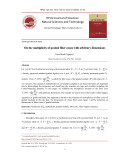
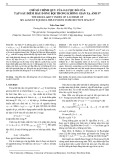
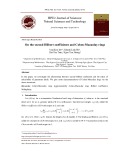
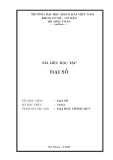

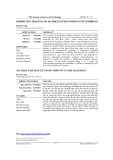
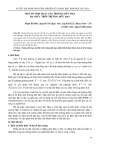
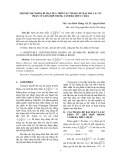
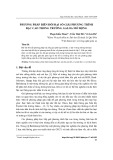

![Đề thi kết thúc học phần Nguyên lí Hóa học 2 [mới nhất]](https://cdn.tailieu.vn/images/document/thumbnail/2025/20251014/anhinhduyet000/135x160/69761760428591.jpg)













